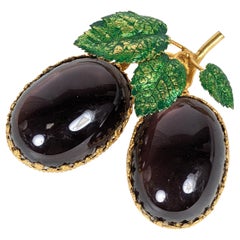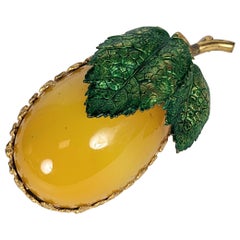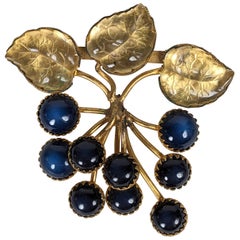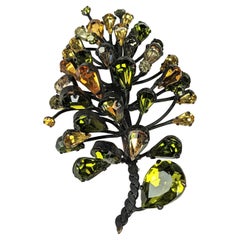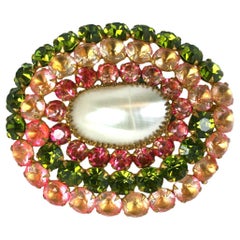Countess Cis Brooches
6
to
6
6
3
3
8
433
413
392
237
5
1
4
3
3
5
Creator: Countess Cis
Countess Cis Bakelite Cherry Brooch
By Countess Cis
Located in New York, NY
Rare Countess Cis Bakelite Cherry Brooch from the 1960's. Designed with a bakelite cherries with hand enamel leaves set into gilt bronze filigree settings. Unsigned but recognized as...
Category
1960s French Artisan Vintage Countess Cis Brooches
Materials
Brass, Bronze
Large Countess Cis Double Plum Brooch
By Countess Cis
Located in New York, NY
Rare Countess Cis Bakelite Double Plum Brooch from the 1960's. Designed with large bakelite "plums" set into gilt bronze filigree band with hand enamel leaves. Cabochons are pale amy...
Category
1960s French Artisan Vintage Countess Cis Brooches
Materials
Brass, Bronze
Countess Cis Bakelite Plum Brooch
By Countess Cis
Located in New York, NY
Rare Countess Cis Bakelite Plum Brooch from the 1960's. Designed with a large bakelite "plum" set into gilt bronze filigree band with hand enamel leaves. Unsigned but recognized as a...
Category
1950s French Artisan Vintage Countess Cis Brooches
Materials
Brass
Countess Cis Berry Brooch
By Countess Cis
Located in New York, NY
Rare Countess Cis Berry Brooch from the 1960's. Designed with a deep blue glass berries with molded citrine glass leaves set into gilt bronze filigree set...
Category
1960s French Artisan Vintage Countess Cis Brooches
Materials
Brass, Bronze, Gilt Metal
Dimensional Countess Cis Jeweled Pine Cone Brooch
By Countess Cis
Located in New York, NY
Amazing Countess Cis Jeweled Pine Cone Brooch from the 1950's. Very dimesional and completely hand made of twisted metalwork and colored crystals in tones of citrine and peridot, all...
Category
1950s French Artisan Vintage Countess Cis Brooches
Materials
Gilt Metal
Countess Cis Jeweled Mother of Pearl Brooch
By Countess Cis
Located in New York, NY
Countess Cis Mother of Pearl Jeweled Brooch. Countess Cis is known for her unusual color combinations as well her unusual materials. A white mother of pearl "jewel" forms the centerp...
Category
1950s French Vintage Countess Cis Brooches
Materials
Gilt Metal
Related Items
1950s European platinum and 18 carat gold diamond brooch
Located in London, GB
This strikingly elegant European made brooch from the 1950s consists of approximately 5.5 carats of diamonds set in platinum. The diamonds are round cut and F-G colour VS clarity. Th...
Category
1950s European Modern Vintage Countess Cis Brooches
Materials
Gold, Platinum
Fancy Vivid Yellow Diamond Dragonfly Brooch
By Fred Leighton
Located in New Orleans, LA
Enveloped in a sea of 60.26 carats of fancy vivid yellow diamonds is this tour de force of jewelry craftsmanship from the collaboration of jewelry legends Fred Leighton and Carvin French. Made for Patricia Kluge...
Category
20th Century American Contemporary Countess Cis Brooches
Materials
Yellow Diamond, Ruby, 18k Gold, Yellow Gold
Antique 9ct Gold Stamped 1960’s Mother of Pearl, Onyx & Diamond Cat Brooch
Located in Brighton, GB
Antique Cat Brooch
9ct Gold Stamped
Circa 1960s
This gorgeous antique cat brooch is a must-have for any collector. Made of 9ct gold and stamped ...
Category
Mid-20th Century English Countess Cis Brooches
Materials
Diamond, Onyx, Pearl, Gold, 9k Gold
Free Shipping
H 1.32 in W 0.58 in
John Brogden Shell Cameo Brooch and Earrings, English, circa 1870
By John Brogden
Located in London, GB
Antique shell cameo brooch and earrings by John Brogden, English, circa 1870. A yellow gold suite of jewellery, the brooch composed of a horizontally situated oval Bull’s Mouth shell cameo of the Greek goddess Selene riding a serpentine dragon in a rubover collet setting, encircled by a conforming frame of gold beading and twisted gold wire punctuated with four gold palmette form plaques engraved and decorated with dark blue enamel and placed at the cardinal points, the reverse mounted with a hinged pin and scroll clasp, the earrings each composed of a vertical oval Bull’s Mouth shell cameo engraved with a bust length portrait of Selene with crescent-set headdress, encircled by a conforming frame matching that of the brooch with the addition of a pendant decoration composed of a horizontal bar of gold beading and twisted gold wires suspending gold link chains graduated from centre and ending in conical gold elements, the reverses mounted with French wire fittings, all in a fitted red leather case, the interior marked ‘FIRST CLASS PARIS MEDAL/ 1855.1867.1851/ PARIS FIRST CLASS & LONDON PRIZE MEDALS/ JOHN BROGDON/ Goldsmith/ MANUFACTORY/ 16, Henrietta St. Covent Garden/ London’.
The cameo—defined as a gem, usually either a mineral or a shell, upon which a design has been carved in relief—is believed to have originated in Hellenistic Greece, during the third century BC. These miniature sculptures, at that time confined to the medium of hardstone, are thought to have been made with the primary purpose of personal adornment. The same practice of mounting cameos in jewellery was then continued by the Ancient Romans, and they are known to have been worn by many a Roman emperor.
After the fall of Rome the fashion for cameos went into a decline, until it was again revived during the Renaissance period, brought about by a keen interest in the ancient world. At this time both antique and contemporary cameos were mounted in jewellery, as well as collected as objet d’art. The art of cameo cutting was revived in Italy, where it would remain a centre for the coming centuries. Again there was a lull in interest in carved gemstones, until the Neoclassical revival of the eighteenth century, largely stimulated by the discoveries of the ancient Roman cities of Pompeii and Herculaneum. As with the Renaissance, antique specimens were generally prized over modern cameos, and the worldliest men in Europe held them among their collections of art and antiques. That said, carving centres in Rome and Torre del Greco (near Naples) in Italy were established in response to the demand of the Grand Tourists, who travelled to Italy and Greece to become educated in the wonders of the ancient world. It was at this time that shell cameos, mostly made in Torre del Greco due to its proximity to the sea, became more popular, owing to the relative ease in carving shell over hardstone. In addition to Rome, hardstone cameos also became a specialty of Idar Oberstein, Germany, which had a long history with both the gem mining and cutting trade.
In a shift away from the collector’s cases of the previous century, the nineteenth century saw a strengthening in the fashion for wearable cameos. After the Empress Josephine donned a cameo-set suite of jewellery at the coronation of Napoleon in 1804, cameo jewellery became all the rage. Napoleon played a further hand in promoting the art by establishing a gemstone carving school in Paris, inspired by his appreciation for the arts of the ancient world. By the mid-nineteenth century shell cameos, in part due to their lightness compared with hardstone cameos, were the height of fashion. Large shell cameos as well as hardstone cameos were set into contemporary mounts, often as suites of jewellery. Some of the best cameos of the nineteenth century—carved by a select group of recognized carvers—were set into revivalist mounts, corresponding to the subject matter.
In Victorian England cameo jewellery was particularly prized, due in part to the fact that the Queen owned and wore a number of cameo jewels. One example which can often be seen in official portraits is the Badge of the Order of Victoria and Albert, carved by Tommaso Saulini of Rome, who also produced cameos for the maker of the present suite, John Brogden. To meet demand some carvers set themselves up in London, including William Schmidt, a German carver from Idar Oberstein, who produced cameos for top London jewellers, including Brogden, Carlo Giuliano and Child & Child. In fact, Schmidt purports to have been the first to carve cameos out of opal, which Brogden reportedly displayed in the Paris Exhibition of 1878. An extant example, now in the collection of the British Museum, was set by the Giuliano firm.
Regarding subject matter, cameos throughout time have been largely figural, from bust length profile portraits to scenes with multiple full-length figures, and sometimes animals. Ancient Greek and Roman cameos often depicted mythological scenes as well as contemporary figures. During the Renaissance, mythological scenes were popular, often taken directly from ancient sculpture, as well as portraits of notable contemporary figures. During the eighteenth and nineteenth centuries, due to the revivalist styles, both Renaissance and Classical subjects were copied and set into matching (and sometimes unmatching) revivalist mounts. From the Renaissance through the Victorian era, being able to recognize the source of the carving in a cameo was a mark of erudition, revealing in the wearer knowledge of Classical art.
As mentioned, the present cameo parure...
Category
1870s English Victorian Antique Countess Cis Brooches
Materials
Yellow Gold
David Webb Platinum 40 Carat Diamond Feather Set of Two Brooches
By David Webb
Located in New York, NY
Pair of impressive platinum and 18k gold leaf brooches by David Webb, with a total of approximately 40 carats in round and baguette cut H/VS-SI1 d...
Category
20th Century American Modern Countess Cis Brooches
Materials
Diamond, Platinum
Cartier New York GIA Certified 11.24 Carat Old Mine Cushion Diamond Brooch
By Cartier
Located in Miami, FL
Magnificent Cartier Art Deco Platinum and Diamond Brooch featuring a matching pair of important Old Mine Cut Diamonds weighing 5.60 carats and 5.64 carats. Both accompanied by a GIA report stating that they are H color VS1 and H color VS2 clarity. This brooch comes with an Expertise letter from IAJA (international Antique Jewelers...
Category
1930s American Art Deco Vintage Countess Cis Brooches
Materials
Diamond, Platinum
Victorian amethyst and citrine brooch, circa 1860.
Located in London, GB
Victorian amethyst and citrine brooch. Set to centre with one round old cut citrine in an open back claw setting with an approximate weight of 60 carats, encircled by four round old ...
Category
1860s Antique Countess Cis Brooches
Materials
Amethyst, Citrine, Yellow Gold
David Webb Platinum 40.00 Carat Old Cut Diamond Brooch
By David Webb
Located in New York, NY
Of particular interest and rarity this David Webb mid-century floral
brooch enhanced old-cut diamonds mounted moustly in Platinum with just a few yellow gold petal accents. Total car...
Category
20th Century American Modern Countess Cis Brooches
Materials
Diamond, 18k Gold, Platinum
Carved Coral Buddha Pendant in 18k Gold Set with Diamonds, Emeralds and Rubies
Located in Honolulu, HI
MAGNIFICENT large vintage Buddha pendant brooch in 18K yellow gold. This gorgeous pendant features a stunning Buddha carved in natural coral set...
Category
Late 20th Century Unknown Countess Cis Brooches
Materials
Coral, Diamond, Emerald, Ruby, 18k Gold
A Black Galalith, silver and clear paste clip, Mecan, France, 1930s
Located in Greyabbey, County Down
A very stylish and rare jewel, high Art Deco in style and manufacture.
This is a clip fitting, bold and strong, that would clip onto a clutch bag, a lapel, or on the edging of a low ...
Category
1930s French Art Deco Vintage Countess Cis Brooches
Materials
Silver
Free Shipping
H 1.6 in W 2.4 in D 0.2 in L 2.4 in
Stickpin
Located in Orimattila, FI
According to the picture.
I don't know what material.
It's old.
Category
Mid-20th Century Unknown Early Victorian Countess Cis Brooches
Marcus & Co. Sapphire and Diamond Bow Brooch, American, circa 1935
Located in London, GB
Sapphire and diamond bow brooch by Marcus & Co, American, circa 1935. A yellow gold and platinum bow form brooch set with one central row of twenty eig...
Category
1930s American Art Deco Vintage Countess Cis Brooches
Materials
Diamond, Sapphire, Platinum
Countess Cis brooches for sale on 1stDibs.
Find a range of Countess Cis brooches available on 1stDibs. Each of these unique items was designed with extraordinary care, often using gilt metal. We have 2 pieces in this collection as well as a number of other designs by this jeweler. While this collection reflects work that originated over various time periods, most of these items were designed during the 1950s. If you’re looking for additional options, many customers also consider brooches by Chanel, and Herve Van Der Straeten. Prices for Countess Cis brooches can differ depending upon gemstone, time period and other attributes. On 1stDibs, the price for these items starts at $2,250 and tops out at $2,850, while pieces like these, on average, can sell for $2,550.

